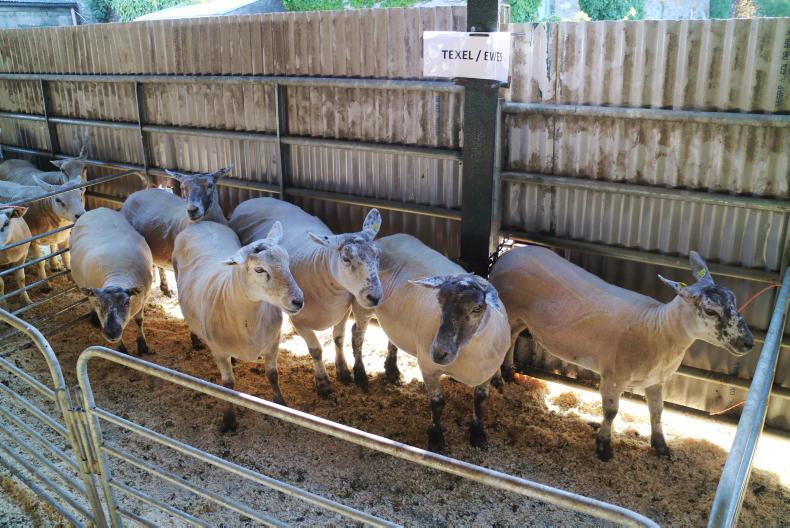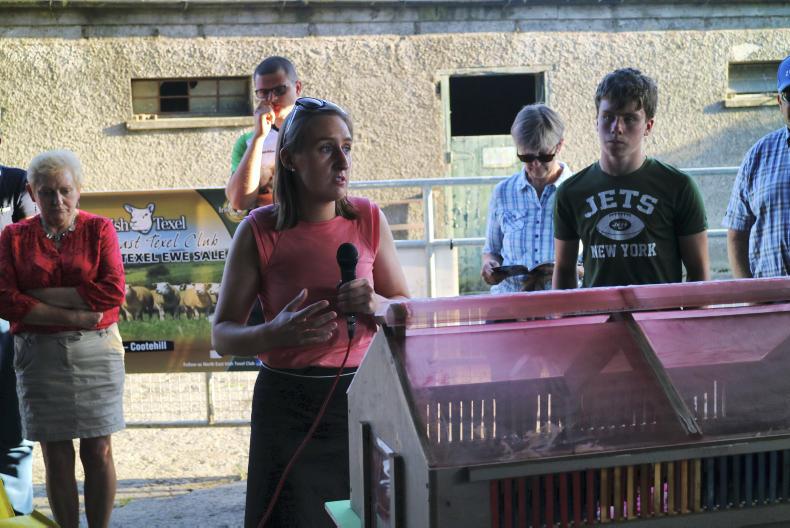Vaccines can play a vital role in reducing antibiotic usage in all livestock systems. This was the view of Sarah Campbell, vet with MSD Animal Health, speaking at Friday’s North East Irish Texel Club information evening held on the farm of Ronan and Michael Delany, Gaulstown House, Dunshaughlin, Co Meath.
Sarah said the success of vaccines is directly linked to using them correctly, which means closely following manufacturers guidelines. She said that in general once you have opened a vaccine, you only have a window of a few hours in which to use it. The exact time frame differs between vaccines and this is another reason according to Sarah why it is vital to follow guidelines set out by the company.
It is better when you are going to the trouble of getting the sheep in to make sure you are getting value for your money and not going to a lot of trouble for no benefit
“People often ask us if resealing the vaccine bottle with candle grease or the likes and storing in a fridge will allow it to be used at a later day. The fridge won’t save it and it is better when you are going to the trouble of getting the sheep in to make sure you are getting value for your money and not going to a lot of trouble for no benefit.”

When administering vaccines, two treatments are required to trigger maximum immunity.
Storage is another vital component, with vaccines required to be stored in a refrigerator. This element is particularly under the spotlight at present given the high temperatures and farmers were warned to be mindful of getting the vaccine to a refrigerator if not using directly after purchasing. Temperatures in vehicles can increase sharply in current weather and farmers need to be mindful that exposing vaccines to these kinds of temperatures can render the medicine useless.
The final piece of advice in terms of handling vaccines related to shaking the vaccine before use. “With Heptavac P in particular, the vaccine will settle and you will see sediment starting to appear. It is important to shake the vaccine well and even at stages during use if you see any settling occurring.”
Two shots required for maximum protection
Farmers raised questions as to the need to deliver a second or booster shot. Sarah said that administering a single vaccine treatment will bring about a level of protection but that a booster shot is required to trigger maximum immunity.
Lameness was raised as a big concern on farms at present. Farmers were told that the first step in implementing a control programme was to determine the cause and extent of the problem. Footbathing is a good option in dealing with scald in lambs and will help in limiting the spread of footrot but Sarah said that footbathing on its own will not resolve a footrot issue in a flock. In such cases, systemic treatment via antibiotics (spray or injection) will be required while the Footvax vaccine has treatment and preventative properties and is a good option.
Read more
Sheep management: grass, concentrates and transport
Vaccines can play a vital role in reducing antibiotic usage in all livestock systems. This was the view of Sarah Campbell, vet with MSD Animal Health, speaking at Friday’s North East Irish Texel Club information evening held on the farm of Ronan and Michael Delany, Gaulstown House, Dunshaughlin, Co Meath.
Sarah said the success of vaccines is directly linked to using them correctly, which means closely following manufacturers guidelines. She said that in general once you have opened a vaccine, you only have a window of a few hours in which to use it. The exact time frame differs between vaccines and this is another reason according to Sarah why it is vital to follow guidelines set out by the company.
It is better when you are going to the trouble of getting the sheep in to make sure you are getting value for your money and not going to a lot of trouble for no benefit
“People often ask us if resealing the vaccine bottle with candle grease or the likes and storing in a fridge will allow it to be used at a later day. The fridge won’t save it and it is better when you are going to the trouble of getting the sheep in to make sure you are getting value for your money and not going to a lot of trouble for no benefit.”

When administering vaccines, two treatments are required to trigger maximum immunity.
Storage is another vital component, with vaccines required to be stored in a refrigerator. This element is particularly under the spotlight at present given the high temperatures and farmers were warned to be mindful of getting the vaccine to a refrigerator if not using directly after purchasing. Temperatures in vehicles can increase sharply in current weather and farmers need to be mindful that exposing vaccines to these kinds of temperatures can render the medicine useless.
The final piece of advice in terms of handling vaccines related to shaking the vaccine before use. “With Heptavac P in particular, the vaccine will settle and you will see sediment starting to appear. It is important to shake the vaccine well and even at stages during use if you see any settling occurring.”
Two shots required for maximum protection
Farmers raised questions as to the need to deliver a second or booster shot. Sarah said that administering a single vaccine treatment will bring about a level of protection but that a booster shot is required to trigger maximum immunity.
Lameness was raised as a big concern on farms at present. Farmers were told that the first step in implementing a control programme was to determine the cause and extent of the problem. Footbathing is a good option in dealing with scald in lambs and will help in limiting the spread of footrot but Sarah said that footbathing on its own will not resolve a footrot issue in a flock. In such cases, systemic treatment via antibiotics (spray or injection) will be required while the Footvax vaccine has treatment and preventative properties and is a good option.
Read more
Sheep management: grass, concentrates and transport







 This is a subscriber-only article
This is a subscriber-only article










SHARING OPTIONS: